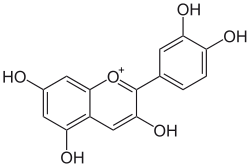Cyanidin
| Cyanidin | |
|---|---|
 | |
| IUPAC name 2-(3,4-Dihydroxyphenyl) chromenylium-3,5,7-triol | |
| Other names Cyanidine | |
| Identifiers | |
| CAS number | 13306-05-3 |
| PubChem | 128861 |
| ChemSpider | 114193 |
| KEGG | C05905 |
| ChEBI | CHEBI:27843 |
| ChEMBL | CHEMBL404515 |
| Jmol-3D images | {{#if:C1=CC(=C(C=C1C2= C(C=C3C(=CC(=CC3= [O+]2)O)O)O)O)OOc1ccc(cc1O)c3[o+]c2cc(O)cc(O)c2cc3O|Image 1 Image 2 |
| |
| |
| Properties | |
| Molecular formula | C15H11O6+ |
| Molar mass | 287.24 g/mol |
| Except where noted otherwise, data are given for materials in their standard state (at 25 °C (77 °F), 100 kPa) | |
| Infobox references | |
Cyanidin is a natural organic compound. It is a particular type of anthocyanidin (not to be confused with anthocyanins which are glycosides of anthocyanidins). It is a pigment found in many red berries including but not limited to grapes, bilberry, blackberry, blueberry, cherry, cranberry, elderberry, hawthorn, loganberry, acai berry and raspberry.[1] It can also be found in other fruits such as apples and plums, and in red cabbage and red onion. It has a characteristic reddish-purple color, though this can change with pH; solutions of the compound are red at pH < 3, violet at pH 7-8, and blue at pH > 11. The highest concentrations of cyanidin are found in the seeds and skin of a given fruit.[citation needed]
Effects on the human body
Cyanidin, like other anthocyanidins, has putative antioxidant and radical-scavenging effects which may protect cells from oxidative damage and reduce risk of cardiovascular diseases and cancer. One theory is that dietary intake of cyanidins may inhibit development of obesity and diabetes as well as provide anti-inflammatory effects.[2]
Other preliminary studies indicate that the glucoside derivative of cyanidin might have a role in cancer therapy, although this remains unproven beyond laboratory testing.[3][4][5]
List of cyanidin derivates
- Antirrhinin (cyanidin-3-rutinoside or 3-C-R)
- cyanidin 3-O, found in red onion
- cyanidin 7-O, found in red onion
- cyanidin 3,4′-di-O-β-glucopyranoside, found in red onion
- cyanidin 4′-O-β-glucoside, found in red onion
- Chrysontemin (cyanidin-3-O-glucoside) found in blackcurrant pomace
References
- ↑ http://www.phytochemicals.info/phytochemicals/cyanidin.php[]
- ↑ Sasaki, R; Nishimura, N; Hoshino, H; Isa, Y; Kadowaki, M; Ichi, T; Tanaka, A; Nishiumi, S et al. (2007). "Cyanidin 3-glucoside ameliorates hyperglycemia and insulin sensitivity due to downregulation of retinol binding protein 4 expression in diabetic mice". Biochemical Pharmacology 74 (11): 1619–27. doi:10.1016/j.bcp.2007.08.008. PMID 17869225.
- ↑ Fimognari, Carmela; Berti, Fausto; Nüsse, Michael; Cantelli Forti, Giorgio; Hrelia, Patrizia (2005). "In vitro Antitumor Activity of Cyanidin-3-O-β-Glucopyranoside". Chemotherapy 51 (6): 332–5. doi:10.1159/000088956. PMID 16224184.
- ↑ Chen, Pei-Ni; Chu, Shu-Chen; Chiou, Hui-Ling; Kuo, Wu-Hsien; Chiang, Chui-Liang; Hsieh, Yih-Shou (2006). "Mulberry anthocyanins, cyanidin 3-rutinoside and cyanidin 3-glucoside, exhibited an inhibitory effect on the migration and invasion of a human lung cancer cell line". Cancer Letters 235 (2): 248–59. doi:10.1016/j.canlet.2005.04.033. PMID 15975709.
- ↑ Tulio, Artemio Z.; Reese, R. Neil; Wyzgoski, Faith J.; Rinaldi, Peter L.; Fu, Ruiling; Scheerens, Joseph C.; Miller, A. Raymond (2008). "Cyanidin 3-Rutinoside and Cyanidin 3-Xylosylrutinoside as Primary Phenolic Antioxidants in Black Raspberry". Journal of Agricultural and Food Chemistry 56 (6): 1880–8. doi:10.1021/jf072313k. PMID 18290621.
| ||||||||||||||||||||||||||||||||